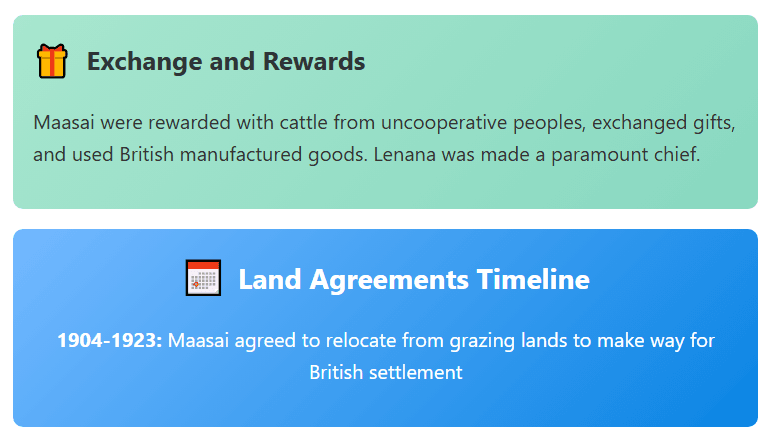🏛️ The Maasai Collaboration with the British
A Comprehensive Tutorial on 19th Century East African History
📚 Learning Objective: Understand how the once-feared Maasai community transformed from a position of strength to collaboration with British colonial forces in the 19th century.
🏺 Historical Context
In the 19th century, the Maasai community underwent a dramatic transformation. Once a feared and powerful community, they became weakened by internal succession disputes and natural disasters, ultimately leading them to collaborate with British colonial forces.
🤝 Reasons for Maasai Collaboration
⚔️ Loss of Military Supremacy
By the time the British arrived in Kenya, the Nandi had overtaken the Maasai in military superiority. The Maasai sought foreign support against their new aggressors.
👥 Internal Feuds and Succession Disputes
Between 1850 and 1890, succession disputes caused by differences in economic activities weakened the community. When Lenana appeared to be losing to Sendeyo, he appealed to the British for support.
🌪️ Natural Calamities and Disasters
The 1850s brought severe hunger, livestock diseases, and human diseases to Maasai country, significantly weakening their ability to resist foreign intervention.
🛡️ Threats from the Agikuyu
When the Maasai attempted to reclaim their women and children after the hunger period, they faced threats of attacks from the Agikuyu, prompting them to seek British support.
🔮 Mbatian’s Prophecy
Mbatian prophesied the coming of a more powerful white man and advised the Maasai not to resist him.
👑 Lenana’s Personal Motivations
Lenana chose collaboration to consolidate his position and kingdom, seeking military support to overcome his sibling Sendeyo of the Loita Maasai.
📋 The Collaboration Process
🎯 Initial Contact
Lenana’s attempt to secure assistance against Sendeyo marked the beginning of his collaboration with the British.
💥 The Kedong Massacre Incident
Maasai warriors attacked a caravan of Swahili and Agikuyu traders. The resultant death of 100 Maasai at the hands of three white men (Andrew Dick and two French companions) made the Maasai immediately seek collaboration with the British.
🏛️ Administrative Cooperation
The Maasai cooperated in establishing colonial administration and provided mercenaries for British punitive expeditions against the Nandi, Kipsigis, and Kikuyu.
🎁 Exchange and Rewards
Maasai were rewarded with cattle from uncooperative peoples, exchanged gifts, and used British manufactured goods. Lenana was made a paramount chief.
📅 Land Agreements Timeline
1904-1923: Maasai agreed to relocate from grazing lands to make way for British settlement
📜 First Maasai Agreement (1904)
The Maasai moved into two reserves: one south of Ngong and the railway, and another on the Laikipia plateau. A 5-kilometer corridor was set aside in Kinangop for the Eunoto ceremony.
📋 Second Maasai Agreement (1911)
The Maasai abandoned the Laikipia plateau to rejoin others in the enlarged southern reserve.
📊 Results of the Collaboration
✅ Positive Outcomes
👑 Political Recognition
Lenana was made paramount chief of the Maasai in 1901.
🐄 Material Rewards
The Maasai gained cattle and grains looted from resisting communities like the Nandi and Luo of Ugenya.
💼 Employment Opportunities
Some Maasai were hired as mercenaries against resisting communities such as the Nandi and Agikuyu.
❌ Negative Consequences
💔 Community Separation
The collaboration led to the separation of Maasai-related clans. The Purko Maasai were divided into the Loita and Ngong Maasai.
🏞️ Massive Land Alienation
The Maasai were moved to the Ngong and Laikipia reserves and later to the southern reserve.
🎭 Cultural Restrictions
Freedom in conducting rituals was curtailed with confinement to a five-square-mile reserve for initiation rites.
🔗 Loss of Independence
The Maasai lost their independence as Maasailand became part of the British protectorate.
🌍 Territorial Disruption
Complete disruption of territorial integrity and cattle economy, with attempts to abandon nomadic habits.
🐃 Livestock Impact
Cross-breeding customs with Samburu neighbors were disrupted, weakening their livestock through curtailed migratory behavior.

